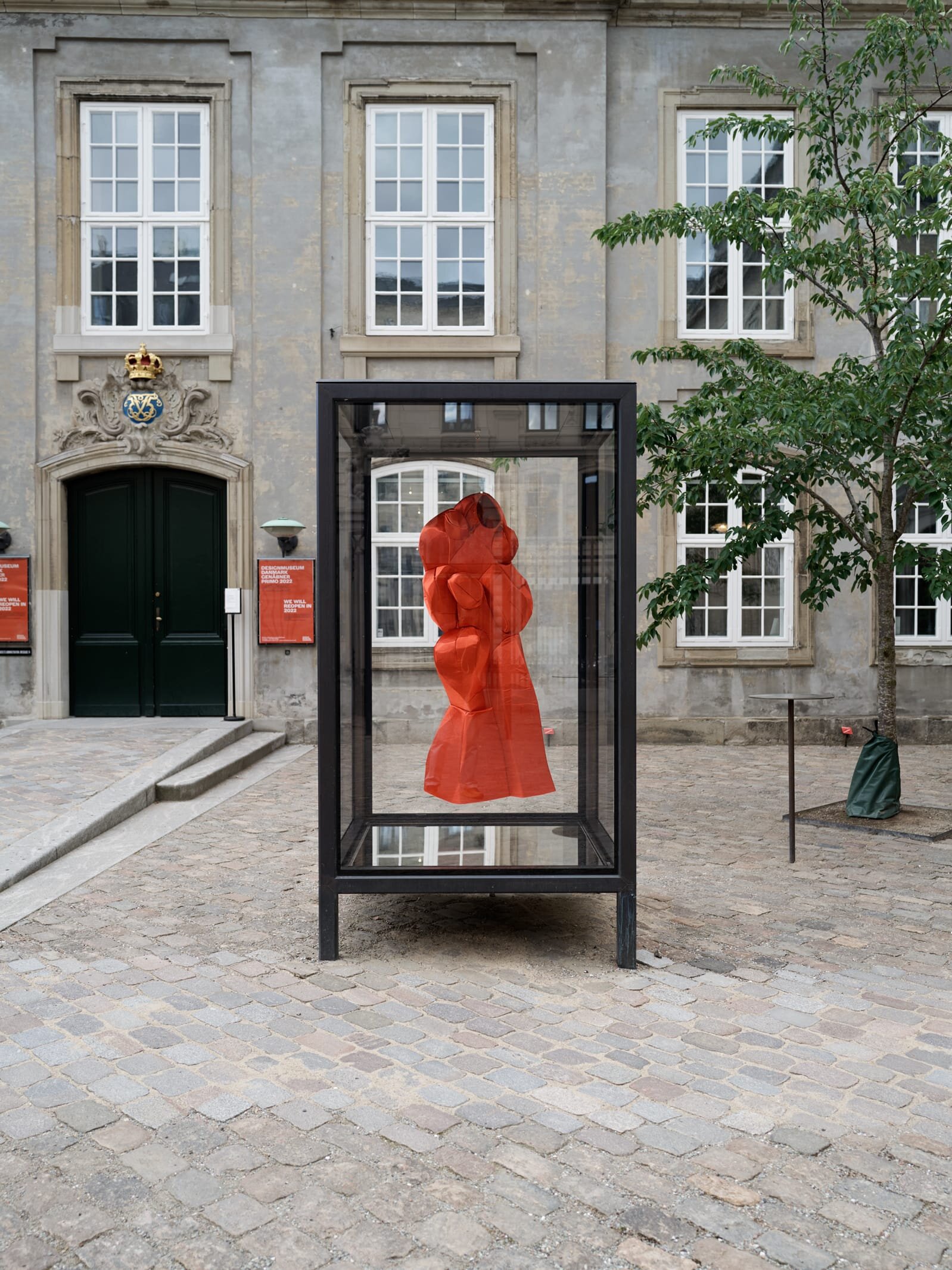
As the exhibition’s title, Absent Bodies, suggests, the body is absent in all of the works, which illustrates how five, emerging Nordic designers use their work to explore and challenge the special conventions and ideals that exist in the close relationship between body, fashion and culture.
Amina Saada, Courtney Makins, Fredrik Stålhandske, Ishara Jayathilake and Oliver Oppermann are unique talents who rethink the principles of fashion design. They approach fashion through the lens of contemporary societal issues such as sustainability, power relationships, mental health, and identity in a global perspective. All works are commissioned for the exhibition and designed specially for the glass display cases.
The exhibition is curated by Ane Lynge-Jorlén, director of ALPHA, and Pernille Stockmarr, curator and museum inspector at Designmuseum Danmark.
Courtney Makins
Title: The Love Scene & The Balancing Act
Materials: Love Scene: Coated cotton houndstooth and polyester ripstop. Balancing Act: Coated wool tartan, cotton and cotton Houndstooth
Year: 2019
Courtney Makins is a Master graduate from the Swedish School of Textiles in Borås, Sweden. Born in South Africa and raised in Perth, Australia, her graduate work has explored a vast variety of different and unusual materials. Her work titled ‘Absent Bodies’ uses the absence of the body to have an impact on how we perceive garments and fashion. Using an experimental and eco-friendly coating her garments become very sculptural in their nature by portraying the essence of the body. These sculptures develop a language in their own right to be able to communicate ideas through known forms with these two individual pieces titled ‘The Love Scene’ and ‘The Balancing Act’. Her work aims to broaden the potential methods of garment display and presentation, merging the boundaries between fashion and art.
Amina Saada
Title: The Red Bride
Material: Polyester satin and foam
Year: 2020
The work of Amina Saada, a graduate of Aalto University in Finland, centres on finding new shapes and ways to make clothing that can be presented as sculptures. Finding beauty in what is largely considered ugly, The Red Bride takes inspiration from cocoons in nature, which are generally labelled ugly, yet contain beautiful and fragile butterflies inside of them. Similar to the transformative stages of a butterfly’s life, is a bride at her wedding, at the cusp of a new life. Being a bride represents one most beautiful rites of passage. Taking cues from 60s bridal wear and mourning wear, the shape, colour and fabric of Amina’s wearable sculpture encapsulates the idea of transformable beauty.
Fredrik Stålhandske
Title: People go to Work
Material: Monofilament polyester, wood and foam boards
Year: 2020
People go to work, and people come home from work. Playing roles in their lives, going in and out of character. We create our own characters depending on where we are and with whom. Growing up with a banking father and his suited visual identity, Swedish fashion designer and a graduate of The Swedish School of Textiles, Fredrik Stålhandske explores dress codes and their boundaries within the business world. “People go to Work” is based on childhood memories and the ways in which our social identities are constructed through dress. Straddling art, design and fashion, this installation shows three people getting into character and ready for work.
Oliver Oppermann
Title: follow4follow
Material: Recycled polyester and dead-stock neoprene
Year: 2020
Danish designer Oliver Oppermann has created the work ‘follow4follow, which is a bubbly sculpture made from bonded dead-stock neoprene. The piece is a comment to our behaviour on social media platforms and bodily discomfort. Oppermann’s work is characterized by a curiosity to examine human behaviour and ideas of beauty. The concept of the installation derives from an exploration of different modern phenomena that have been translated into a new shape, component and colour. Oppermann’s practice challenges our perception of form and our way of life in the 21st century.
Ishara Jayathilake
Title: East meets West
Material: Screen-printed cotton canvas
Year: 2020
The Norway-based graduate of Oslo National Academy of the Arts, Ishara Jayathilake explores colonialism and post-colonialism in a global context. Jayathilake is a keen observer of Sri Lankan culture at the intersection of postcolonial identity and how individual and cultural identity is related to this within a socio-cultural realm. The artwork presents a voluminous crinoline made out of a variation of Sinhalese and English words. The words are taken from several English quotes that relate to colonialization, written by different authors and then translated into Sinhalese. Jayathilake’s work seeks to understand the cross sections of dress and social issues in a post-colonial context.
All images by Alexander Höllsberg









